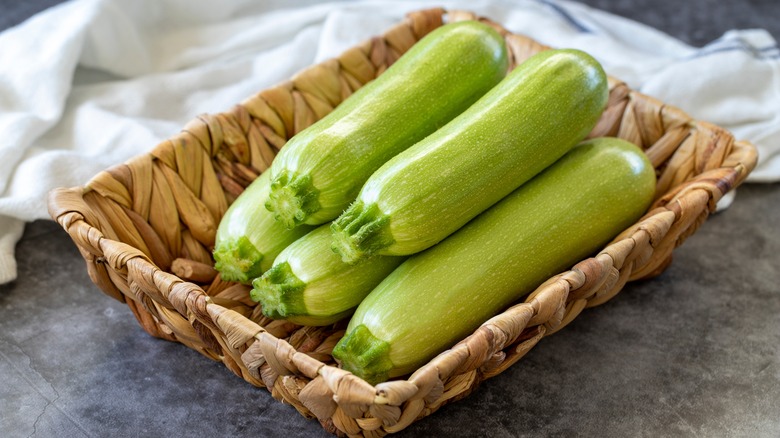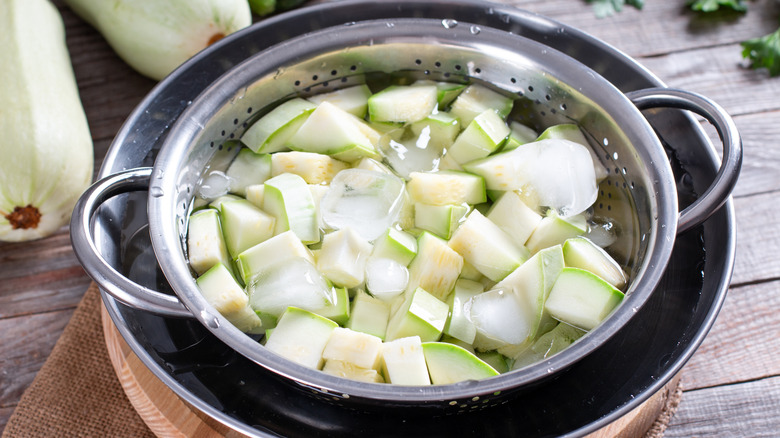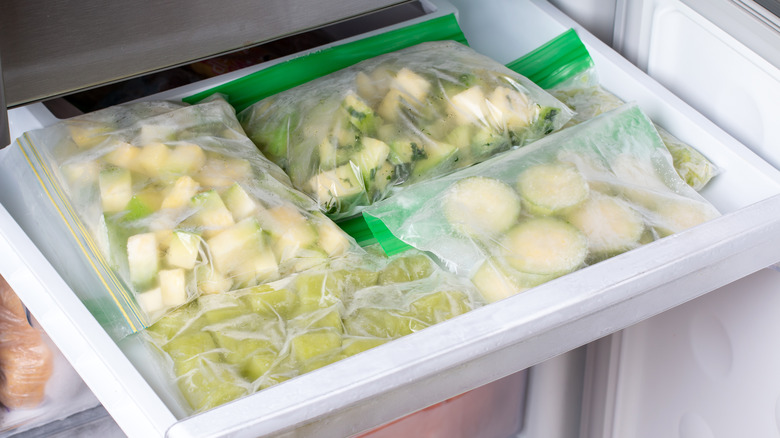The Easiest Way To Freeze Zucchini
The humble zucchini might be one of the most versatile veggies in the kitchen. You can fry, bake, grill, or steam it, mix it into cookie dough, or add it to relishes. Plus, it's just perfect for zoodles and other light meals. Perhaps the only downside is its short shelf-life. This beloved vegetable doesn't last longer than a week in the fridge, so you need to use it up fast.
One solution is to freeze zucchini. But before you do, it's best to blanch it first. Blanching will help preserve its color, flavor, and texture while killing potentially harmful bacteria. Freezing, though, will extend its shelf-life to 10 months.
First, decide how you want to freeze the zucchini. You might grate it beforehand if you plan to use it in baked dishes, veggie burgers, or pesto, or cut it into slices so you can later add them to soups, stews, and casseroles. Shredded zucchini should be steam-blanched, whereas zucchini slices can be blanched in water before freezing.
Blanch the zucchini to preserve its quality
Blanching vegetables before freezing deactivates the enzymes that cause browning and other changes in food color, flavor, or consistency. If you skip this step, the zucchini can develop a soft, mushy texture once thawed and cooked. You may also notice off-flavors, dark spots, and other unwanted changes.
With that in mind, wash the zucchini under running water and trim off their ends. Grate them in a large bowl, squeezing out the excess water. After that, blanch them in a steamer basket over boiling water for one or two minutes. Transfer the zucchini to a small container and place it in a bowl of ice water.
If you prefer to slice the zucchini, you can skip the steaming process. Blanch them for three minutes or so, transfer them to a bowl of ice water, and let them cool. With either method, it's essential to chill the zucchini as quickly as possible to prevent over-blanching. The goal isn't to cook them but to halt the enzymatic activity responsible for quality loss.
Freezing zucchini couldn't be easier
Once the zucchini has cooled, squeeze the water out using paper towels. This extra step helps prevent ice crystal formation during freezing, keeping it crisp. If you have sliced them beforehand, lay the slices out on a tray lined with parchment paper. Freeze them until firm, then transfer them to freezer containers or plastic bags. Shredded zucchini can be placed directly into freezer-safe bags or frozen in ice cube trays.
When you're ready to use the zucchini, thaw them in the refrigerator for a few hours or overnight. Alternatively, pop them in the microwave or warm them up in a skillet until soft. Squeeze them to eliminate excess moisture, then add them to cooked meals, dips, sauces, cakes, or homemade bread.
Grated zucchini can make your cakes ultra moist due to its high water content. It's also a wonderful addition to brownies, bread pudding, scones, and other baked goods. Zucchini slices, on the other hand, can add flavor and texture to lasagna, casseroles, pizzas, and vegetable stews. They're not ideal for salads, but you can cook them along with meat, fish, or vegetables to revive their flavor.


